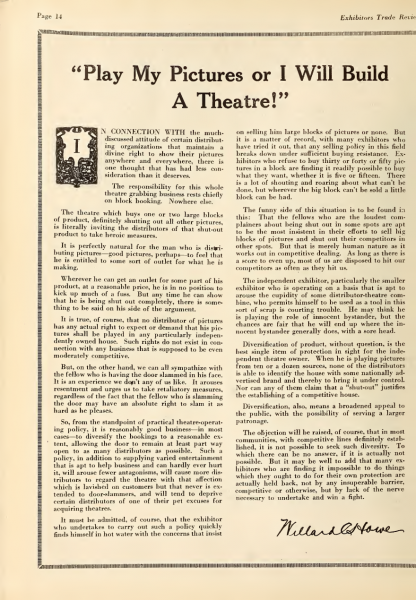| Artifact Type | Sources, Trade Journals |
| Publication | Exhibitors Trade Review |
| Volume | 18 |
| Number | 12 |
| Page Number | 14 |
| Place | New York |
| Publication Date | August 22, 1925 |
| Transcript | Show/Hide |
|
Headline: “Play My Pictures or I Will Build a Theatre!” IN CONNECTION WITH the much-discussed attitude of certain distributing organizations that maintain a divine right to show their pictures anywhere and everywhere, there is one thought that has had less consideration than it deserves. The responsibility for this whole theatre grabbing business rests chiefly on block booking. Nowhere else. The theatre which buys one or two large blocks of product, definitely shutting out all other pictures, is literally inviting the distributors of that shut-out product to take heroic measures. It is perfectly natural for the man who is distributing pictures—good pictures, perhaps—to feel that he is entitled to some sort of outlet for what he is making. Wherever he can get an outlet for some part of his product, at a reasonable price, he is in no position to kick up much of a fuss. But any time he can show that he is being shut out completely, there is something to be said on his side of the argument. It is true, of course, that no distributor of pictures has any actual right to expect or demand that his pictures shall be played in any particularly independently owned house. Such rights do not exist in connection with any business that is supposed to be even moderately competitive. But, on the other hand, we can all sympathize with the fellow who is having the door slammed in his face. It is an experience we don’t any of us like. It arouses resentment and urges us to take retaliatory measures, regardless of the fact that the fellow who is slamming the door may have an absolute right to slam it as hard as he pleases. So, from the standpoint of practical theatre-operating policy, it is reasonably good business —in most cases—to diversify the bookings to a reasonable extent, allowing the door to remain at least part way open to as many distributors as possible. Such a policy, in addition to supplying varied entertainment that is apt to help business and can hardly ever hurt it, will arouse fewer antagonisms, will cause more distributors to regard the theatre with that affection which is lavished on customers but that never is extended to door-slammers, and will tend to deprive certain distributors of one of their pet excuses for acquiring theatres. It must be admitted, of course, that the exhibitor who undertakes to carry out such a policy quickly finds himself in hot water with the concerns that insist on selling him large blocks of pictures or none. But it is a matter of record, with many exhibitors who have tried it out, that any selling policy in this field breaks down under sufficient buying resistance. Exhibitors who refuse to buy thirty or forty or fifty pictures in a block are finding it readily possible to buy what they want, whether it is five or fifteen. There is a lot of shouting and roaring about what can’t be done, but wherever the big block can’t be sold a little block can be had. The funny side of this situation is to be found in this: That the fellows who are the loudest complainers about being shut out in some spots are apt to be the most insistent in their efforts to sell big blocks of pictures and shut out their competitors in other spots. But that is merely human nature as it works out in competitive dealing. As long as there is a score to even up, most of us are disposed to hit our competitors as often as they hit us. The independent exhibitor, particularly the smaller exhibitor who is operating on a basis that is apt to arouse the cupidity of some distributor-theatre combine, who permits himself to be used as a tool in this sort of scrap is courting trouble. He may think he is playing the role of innocent bystander, but the chances are fair that he will end up where the innocent bystander generally does, with a sore head. Diversification of product, without question, is the best single item of protection in sight for the independent theatre owner. When he is playing pictures from ten or a dozen sources, none of the distributors is able to identify the house with some nationally advertised brand and thereby to bring it under control. Nor can any of them claim that a “shut-out” justifies the establishing of a competitive house. Diversification, also, means a broadened appeal to the public, with the possibility of serving a larger patronage. The objection will be raised, of course, that in most communities, with competitive lines definitely established, it is not possible to seek such diversity. To which there can be no answer, if it is actually not possible. But it may be well to add that many exhibitors who are finding it impossible to do things which they ought to do for their own protection are actually held back, not by any insuperable barrier, competitive or otherwise, but by lack of the nerve necessary to undertake and win a fight. — Willard C. Howe |
|
| Archive | The Internet Archive |
| Read In Context | https://archive.org/stream/e00newy#page/n763/mode/2up |
| Citation | Willard C. Howe, “Play My Pictures or I Will Build a Theatre!,” Exhibitors Trade Review, August 22, 1925. |
| Tags | 1920s1925August 1925 |
